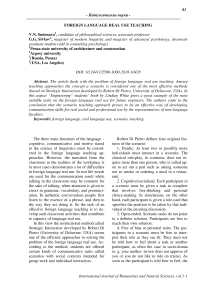Foreign language real use teaching
Автор: Smirnova V.N., Sivkov G.G.
Журнал: Международный журнал гуманитарных и естественных наук @intjournal
Рубрика: Педагогические науки
Статья в выпуске: 1-1 (28), 2019 года.
Бесплатный доступ
The article deals with the problem of foreign language real use teaching. Among teaching approaches the concept a scenario is considered one of the most effective methods (based on Strategic Interaction developed by Robert Di Pietro, University of Delaware, USA). In this aspect “Engineering” students’ book by Lindsay White gives a good example of the most suitable tasks on the foreign language real use for future engineers. The authors come to the conclusion that the scenario teaching approach proves to be an effective way of developing communication skills for real social and professional use by the representatives of non-language faculties.
Foreign language, real language use, scenario, teaching
Короткий адрес: https://sciup.org/170185499
IDR: 170185499 | DOI: 10.24411/2500-1000-2018-10428
Текст научной статьи Foreign language real use teaching
In this view the instructional method called Strategic Interaction developed by Robert Di Pietro (University of Delaware, USA) seems one of the efficient approaches in solving the problem of the foreign language real use. According to the method, students are offered certain kinds of communicative tasks called scenarios with social contexts intended for group work and individual interaction.
Robert Di Pietro defines four original features of the scenario:
-
1. Dyadic. At least two or possibly more individuals must interact in a scenario. The classical role-play, in contrasts, does not require more than one person, who is called upon to act out a part such as asking someone not to smoke or ordering a meal in a restaurant.
-
2. Cognitive/socialized. Each participant in a scenario must be given a task to complete that involves free-thinking and personal choice-making. In simulations, on the other hand, each participant is given a role-card that specifies the position to be taken by that individual in the ensuring discussion.
-
3. Open-ended. Scenario tasks do not point to a definite solution. Participants are free to reach their own solution.
-
4. Free of bias or personal traits. The participants in a scenario must be free to interpret their role as they see fit. They must not be told how to feel about a task or another participant, as often the case in socio-drama (e. g. your mother -in-law does not approve of you or you do not like to ride on trains). As soon as the participant is told how to feel, the
activity becomes a stage performance rather than a life-like search for solutions to problems [1, p. 135].
The following example offered by Robert Di Pietro is typical of the task that can be given to learners to make them functionally orientated in the use of everyday English.
You are going to spend the night in your friend’s apartment while he (or she) is away. Unfortunately, you have lost the key. Your friend told you that the neighbor has an extra key. How will you convince this neighbor that you, a stranger, should be given this key so that you can get into the apartment?
Loss of a key and the need to explain your predicament convincingly to someone who does not know you are not farfetched happenings.
Two additional elements are needed in this activity in order to make it fully interactive: (1) a opposing stance to be taken by another party who has diverse concerns, and (2) the opportunity for groups of learners to work together in mapping out strategies to complete their tasks. So, the opposing stance can be personalized in the form of the “neighbor” who has the extra key. You have an extra key to the apartment next door. The owner of that apartment has asked you to be careful about letting others use the key because there have been several burglaries in the neighborhood. Someone has just come to your door to ask for the key. How will you make certain that this person is sincere and should have? [1, p. 133]. The solutions for this scenario are unpredictable. Such unpredictability is found in real interactions, and learners must become prepared to use English in these circumstances.
Though the problem of teaching a foreign language to university students of engineering programmes combines a lot of difficulties of acquiring adequate translation skills, as we have already mentioned in the previous works [3, p. 234], the modern educational standard implies the requirement that the foreign language real use can be widely applied in the


